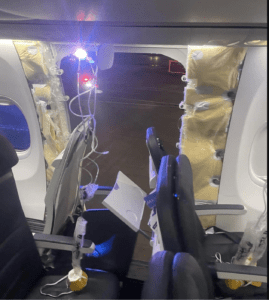
The Federal Aviation Administration ordered U.S. airlines or airlines flying into the United States with the 737 Max 9 to suspend operations of these model aircraft until inspections can be carried out. The statement, issued the afternoon of January 6th did not give details of what needed to be inspected or how they should be carried out but estimated each would take from 4 to 8 hours. One hundred and 71 aircraft are affected, according to the statement.
The limited grounding comes after an Alaska Airlines 737 Max 9 lost a piece of the left side of the fuselage at 16-thousand feet. Headrests from 2 unoccupied seats were sucked from the plane in a rapid and total decompression that terrified passengers.
The pilots declared an emergency and returned to Portland, Oregon where the flight had departed 20 minutes earlier bound for Ontario, California.
The plane came apart at what could be an emergency exit door on the left side for planes configured to carry more passengers. And though it is a door-sized opening it is actually a plug that takes the place of a door for airlines that do not need the additional passenger exit. An interior wall and a row of seats make this opening invisible to travelers. How it failed to seal and whether the problem was the cause of three pressurization alerts over since December 7th is a prime area of investigation for the FAA and the National Transportation Safety Board, both of which are looking into the near-disaster.
Investigators will want to know what indications the pilots did or did not receive and what the maintenance crews did to conclude the airplane was safe to fly on shorter routes but not on extended flights.

Photos of the “false” door on Alaska’s plane N704AL posted on the internet, raise questions about whether the plug was misaligned, or improperly installed and if that triggered the pressurization alerts.
Aircraft mechanic Luis Perez, noted the two door stops circled in the photo below describing them as “adjustment pads” intended to make sure the plug sits properly in the airstream. Should the pad and the steel contact it connects to separate, it will trigger a pressurization alert.
“An installer or mechanic would adjust those bolts to adjust the angle that the door sits. You can see that those bolts are at their max protrusion and that’s a problem at some level,” he told me. “It also looks like the top of these pads are broken off possibly from impact by the plug leaving the aircraft and that some of these pads don’t seem to have wear patterns indicating the adjustment bolts were not in contact.

The FAA’s action Saturday is notably quicker than when two Boeing 737 Max aircraft crashed within five months of each other in October 2018 and March 2019. At that time, the US was one of the last nations to order the airplane grounded. Having responded quickly to the calamitous Flight 1282, other nations appear poised to follow suit. Bloomberg News reported China is considering grounding its 737 Max 9s.
It is not hard for regulators or air travelers to imagine what might have happened to the 177 people on Flight 1282 had the plug failed just a few minutes later in the flight.

On April 17, 2018, a Southwest Airlines flight from New York had an uncontained engine failure. Debris penetrated the cabin and triggered a rapid decompression. Traveler Jennifer Riordan, 43 of New Mexico, was pulled from her seat through the window halfway out of the plane. She died from her injuries.
In the Southwest case, the plane was flying at 32-thousand feet, twice as high as the Alaska flight. The pressure differential was therefore much greater and the exit path for pressurized cabin air was smaller, factors that combined created an even more nightmarish scenario.
But Southwest Flight 1380 also illustrates the flight hazards associated with uncontained engine failures and this, by eerie coincidence, is the subject of a request Boeing just made to the FAA related to its 737 Max 7. It is asking that regulators allow that smaller version of the Max to fly even though its engine’s anti-ice design increases the likelihood of an uncontained engine failure. Boeing proposes pilots use a workaround until it comes up with a permanent solution.
The FAA has yet to decide. Now, it has a more pressing Max problem to deal with.

Author of The New York Times bestseller, The Crash Detectives, I am also a journalist, public speaker and broadcaster specializing in aviation and travel.









I don’t Know what to mean by:
How it failed to seal and whether the problem was the cause of two pressurization alerts the day before is a prime area of investigation for the FAA and the National Transportation Safety Board, both of which are looking into the near-disaster.
“Investigators will want to know what indications the pilots did or did not receive and what the maintenance crews did to conclude the airplane was safe to fly on shorter routes but not on extended flights.”
Because I was on the inbound flight from JFK on that same exact plane and we were up at 34,000 cruising altitude for much of our 5-ish hour flight, we were so lucky.
How is it possible for a plug like door blow out on an aircraft? I’m guessing that door was made of carbon fiber epoxy that suffered delamination which caused it to bulge and depart from the surrounding structure.
It’s hard to be certain it really Was a plug. (Was it?) None of the stuff I’ve read from any source adds up.
Same with the CVR, which “overwrites itself every two hours”. Yes, this is well known, but no two ours elapsed between engine start-up & shut-down. So what’s that all about?
The plug seems to be quite a new thing, even experienced mechanics had a difficult time understanding it. As to the CVR, whoever had responsibility for pulling the circuit breaker failed to do it. In all the hubbub that followed the recorder just kept taping. After two hours, well, you can see how it happened. Readers correct me if I am wrong but I believe pulling the circuit breaker to the CVR is something a pilot is expected to do when the plane is involved in an accident or incident. In this case it would appear the flight crew failed to do so.